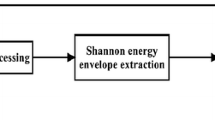Abstract
Extracting and analyzing relevant information from bio-signal recordings are complex tasks in which action potential detection and sorting processes take place, moreover if these are performed in real time. In this regard, the present paper introduces real-time FPGA-based architectures for detection and sorting of bio-signals, in particular macaque and human pancreatic signals. Action potential detection is performed by using an adaptive threshold. Also, during this process we have identified six different action potential shapes from the signals, which have been used to classify the action potentials. Our implementation runs at a frequency of 100 MHz with a low resource consumption for both architectures, and action potentials can be also observed in real time during a simulation in an OLED display.
























Similar content being viewed by others
References
Alghamdi A, Hammad M, Ugail H, Abdel-Raheem A, Muhammad K, Khalifa HS, Abd El-Latif AA (2020) Detection of myocardial infarction based on novel deep transfer learning methods for urban healthcare in smart cities. Multimedia Tools Appl. https://doi.org/10.1007/s11042-020-08769-x
Azami H, Escudero J, Darzi A, Sanei S (2015) Extracellular spike detection from multiple electrode array using novel intelligent filter and ensemble fuzzy decision making. J Neurosci Methods 239:129–138. https://doi.org/10.1016/j.jneumeth.2014.10.006
Belitski A, Gretton A, Magri C, Murayama Y, Montemurro MA, Logothetis NK, Panzeri S (2008) Low-frequency local field potentials and spikes in primary visual cortex convey independent visual information. J Neurosci 28(22):5696–5709. https://doi.org/10.1523/JNEUROSCI.0009-08.2008
Buzsaki G (2006) Rhythms of the brainy. Oxford University Press, New York. https://doi.org/10.1093/acprof:oso/9780195301069.001.000
Gibson S, Judy JW, Markovic D (2010) Technology-aware algorithm design for neural spike detection, feature extraction, and dimensionality reduction. IEEE Trans Neural Syst Rehabil Eng 18(5):469–478. https://doi.org/10.1109/TNSRE.2010.2051683
Harrison R (2003) A low-power integrated circuit for adaptive detection of action potentials in noisy signals. In: Proceedings of the 25th annual international conference of the IEEE engineering in medicine and biology society (IEEE Cat. No. 03CH37439) vol 4, pp 3325–3328. https://doi.org/10.1109/IEMBS.2003.1280856
Hwan Choi J, Kyung Jung H, Kim T (2006) A new action potential detector using the MTEO and its effects on spike sorting systems at low signal-to-noise ratios. IEEE Trans Biomed Eng 53(4):738–746. https://doi.org/10.1109/TBME.2006.870239
Jing H, He X, Han Q, Abd El-Latif AA, Niu X (2014) Saliency detection based on integrated features. Neurocomputing 129:114–121. https://doi.org/10.1016/j.neucom.2013.02.048
Koutsos E, Paraskevopoulou SE, Constandinou TG (2013) A 1.5 \(\mu \)w NEO-based spike detector with adaptive-threshold for calibration-free multichannel neural interfaces. In: Proceedings—IEEE international symposium on circuits and systems, pp 1922–1925. https://doi.org/10.1109/ISCAS.2013.6572243
Lebreton F, Pirog A, Belouah I, Bosco D, Berney T, Meda P, Bornat Y, Catargi B, Renaud S, Raoux M, Lang J (2015) Slow potentials encode intercellular coupling and insulin demand in pancreatic beta cells. Diabetologia 58(6):1291–1299. https://doi.org/10.1007/s00125-015-3558-z
Maji P, Mullins R (2018) On the reduction of computational complexity of deep convolutional neural networks. Entropy 20(4):305. https://doi.org/10.3390/e20040305
Mukhopadhyay S, Ray GC (1998) A new interpretation of nonlinear energy operator and its efficacy in spike detection. IEEE Trans Biomed Eng 45(2):180–187
Obien MEJ, Deligkaris K, Bullmann T, Bakkum DJ, Frey U (2015) Revealing neuronal function through microelectrode array recordings. Front Neurosci 8:423. https://doi.org/10.3389/fnins.2014.00423
Perelman Y, Ginosar R (2007) An integrated system for multichannel neuronal recording with spike/LFP separation, integrated A/D conversion and threshold detection. IEEE Trans Biomed Eng 54(1):130–137. https://doi.org/10.1109/TBME.2006.883732
Pirog A, Bornat Y, Renaud S, Perrier R, Jaffredo M, Raoux M, Lang J (2017) A versatile electrode sorting module for MEAs: implementation in a FPGA-based real-time system. In: 2017 IEEE biomedical circuits and systems conference (BioCAS), pp 1–4
Platkiewicz J, Brette R (2010) A threshold equation for action potential initiation. PLoS Comput Biol 6(7):1–16. https://doi.org/10.1371/journal.pcbi.1000850
Qin Q, Poularakis K, Iosifidis G, Tassiulas L (2018) SDN controller placement at the edge: optimizing delay and overheads. In: IEEE INFOCOM 2018—IEEE Conference on Computer Communications, pp 684–692. https://doi.org/10.1109/INFOCOM.2018.8485963
Rummens F (2015) Embedded systems for the interfacing of electronics and biology : modeling and designing an analog adaptive detection chain. Theses, Université de Bordeaux. https://tel.archives-ouvertes.fr/tel-01294213. Version corrigée/
Rummens F, Renaud S, Lewis N (2015) CMOS differential neural amplifier with high input impedance. In: 2015 IEEE 13th international new circuits and systems conference (NEWCAS), pp 8–11. https://doi.org/10.1109/NEWCAS.2015.7182037
Silbergleit Lehman T, Hilton AD, Lee BC (2018) Maps: understanding metadata access patterns in secure memory. In: 2018 IEEE international symposium on performance analysis of systems and software (ISPASS), pp 33–43. https://doi.org/10.1109/ISPASS.2018.00012
Strauss W (2000) Digital signal processing. IEEE Signal Process Mag 17(2):52–56. https://doi.org/10.1109/79.826412
Takekawa T, Ota K, Murayama M, Fukai T (2014) Spike detection from noisy neural data in linear-probe recordings. Eur J Neurosci 39(11):1943–1950. https://doi.org/10.1111/ejn.12614
Wu T, Xu J, Lian Y, Khalili A, Rastegarnia A, Guan C, Yang Z (2016) A 16-channel nonparametric spike detection ASIC based on EC-PC decomposition. IEEE Trans Biomed Circuits Syst 10(1):3–17. https://doi.org/10.1109/TBCAS.2015.2389266
Yang Y, Mason AJ (2017) Hardware efficient automatic thresholding for NEO-based neural spike detection. IEEE Trans Biomed Eng 64(4):826–833. https://doi.org/10.1109/TBME.2016.2580319
Zhang T, Han Q, El-Latif AAA, Bai X, Niu X (2013) 2-D cartoon character detection based on scalable-shape context and hough voting. Inf Technol J 12:2342–2349
Funding
This work was partial funded by the CONACYT project FC2016-1961 Neurociencia Computacional: de la teoría al desarrollo de sistemas neuromórficos.
Author information
Authors and Affiliations
Corresponding author
Ethics declarations
Conflict of interest
The authors declare that they have no conflict of interest.
Additional information
Publisher's Note
Springer Nature remains neutral with regard to jurisdictional claims in published maps and institutional affiliations.
Rights and permissions
About this article
Cite this article
Iniguez-Lomeli, F.J., Bornat, Y., Renaud, S. et al. A real-time FPGA-based implementation for detection and sorting of bio-signals. Neural Comput & Applic 33, 12121–12140 (2021). https://doi.org/10.1007/s00521-021-05853-7
Received:
Accepted:
Published:
Issue Date:
DOI: https://doi.org/10.1007/s00521-021-05853-7




